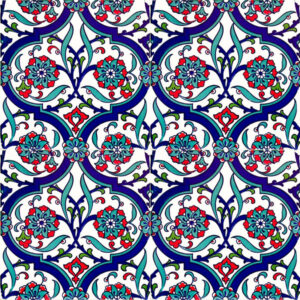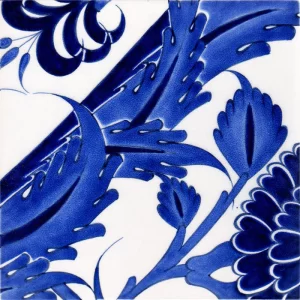Embark on a captivating journey through the annals of history, where the artistry of Turkish tiles unfolds its vibrant narrative. These may look like just pieces of ceramic. But they are embodying a rich cultural heritage. They are storytelling canvases that echo the whispers of the past. Among these, Iznik tiles stand out as a hallmark of craftsmanship and beauty. Thus, holding a special place in the annals of art and architecture.
What Is Tile?
In its most basic term, tile art is the decoration of items such as tiles, porcelain, and ceramics with various figures. Tile art has been used for decorative purposes since ancient times with its beautiful colors and patterns, and continues to exist today.

Tile art, named after China. The Turkish word for tile is “Çini,” which means “from China”. “China” is translated as “Çin” in Turkish. This similarity in words suggests that the introduction of this art into Turkish history is closely related to Chinese culture. The word directly referring to geography proves that the origin of tile art is China. But also shows where the Turks inherited this art from. However, just as cover songs can sometimes be more beautiful than the originals, tile art is also experiencing its golden age in Turkey.
The History of Tile Art
The first examples of tiles, emerging in the Asian region. It was made as glaze and polish. During this period, the purpose of glazing was not aesthetic concerns but functionality. Glazing increases the functionality of earthenware pots. Thus, the pots were glazed both to prevent liquid from leaking and to make them easier to clean.

The first examples of glazed bricks date back to the Sumerian and Assyrian periods. Over time, the finest examples of tile and glazing, spreading to the geography of Iran, are given by the Turkish States. Therefore, tile art, with a history of nearly 5000 years, is today identified with the Turks.
From Small Objects to Architectural Wonders
The biggest turning point in the expansion of tile art from small objects to architecture is the Seljuk period. The Seljuks and Anatolian Seljuks trigger the development of art by using glazed bricks as well as tile plates to decorate their structures. The Ottoman period continues to value tiles. The number of tile production centers and the techniques used increase. Production centers create their styles, directing the course of tile art. Therefore, Iznik, Kütahya, Bursa, and Çanakkale, which are the most important tile production centers of the Ottoman period, still maintain their fame today.

Architectural structures that house the most magnificent examples of Turkish tile art are usually religious and administrative buildings such as mosques, palaces, and madrasahs. The Sultanahmet Mosque (Blue Mosque), named after the thousands of blue-toned tiles it contains, was built in the early 17th century and is famous for its tremendous tile craftsmanship. The Topkapi Palace, the heart of the Ottoman Empire, stands out especially for the magnificent tile panels used in the Harem section.
Iznik Tile On Stage…
The reason why Iznik tile is special is that its production base is made of quartz stone. The high density of quartz gives the tile hardness and durability. It also makes the colors of the tile appear more vibrant, deep, and shiny. Another difference that sets Iznik tiles apart from others is that they consist of four layers. The first layer is the raw tile, the second layer is the primer, the third layer is coloring, and the last layer is glazing.

You recognize Iznik tiles at first sight, for their most distinguishing feature is their colors. In Iznik tiles, only blue, turquoise, green, and red colors are used. For example, Kütahya tiles include a wider and more comprehensive range of colors.
The Renaissance of Iznik Design
Iznik tiles flourished in the 16th and 17th centuries, symbolizing luxury and elegance. Artisans excelled in using silica for the tiles and decorating them uniquely, making Iznik stand out. Their designs were intricate, with bright colors. They used flowers, shapes, and figures to depict nature, myths, and the divine.
Why Are Tiles Blue?

The color used in ceramics is a shade of blue; cobalt blue. This color is like the signature of the art. The reason for the obsession with blue dates back to the 15th century when artists in China protested against the emperor. The artists removed all colors from their ceramics and started using only blue, the color of freedom. Then, these “silent resistance porcelains” sold all around the world. The simplicity of using a single color looked very chic on porcelain. Thus, ceramics became a hit worldwide! We can see this effect in the Ottoman Empire as well; from the 15th century to the middle of the 16th century, only cobalt blue and its shades were used in ceramics.
